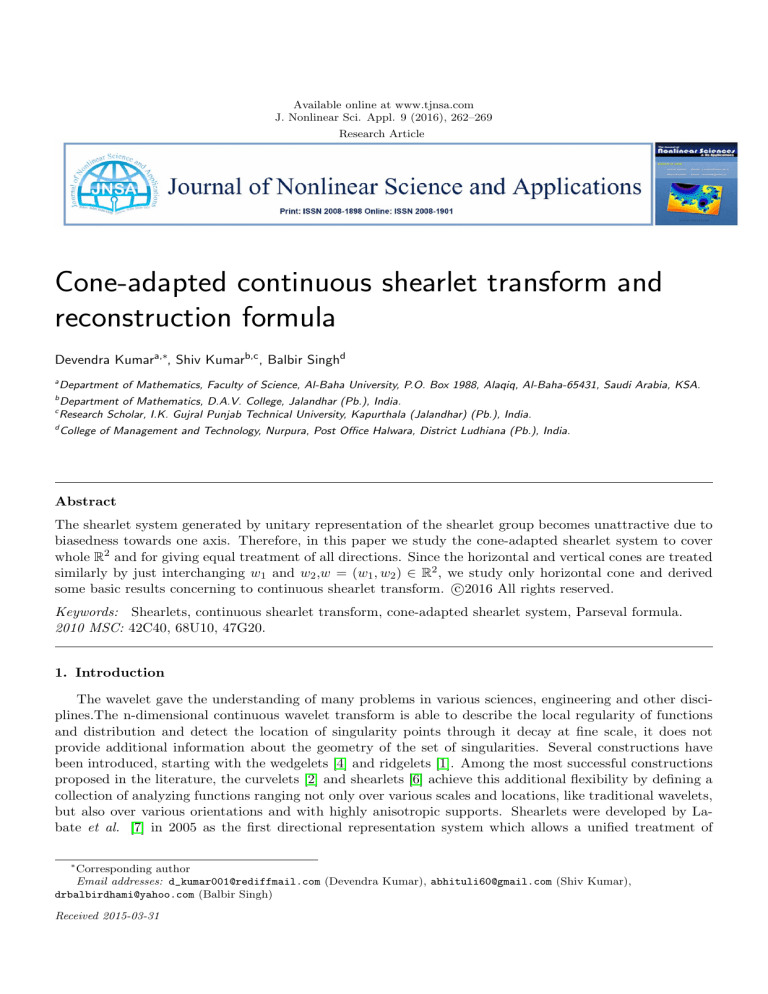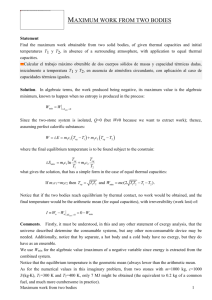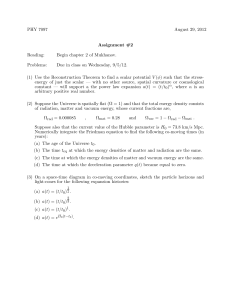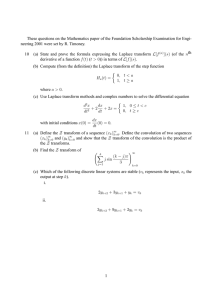
Available online at www.tjnsa.com
J. Nonlinear Sci. Appl. 9 (2016), 262–269
Research Article
Cone-adapted continuous shearlet transform and
reconstruction formula
Devendra Kumara,∗, Shiv Kumarb,c , Balbir Singhd
a
Department of Mathematics, Faculty of Science, Al-Baha University, P.O. Box 1988, Alaqiq, Al-Baha-65431, Saudi Arabia, KSA.
b
Department of Mathematics, D.A.V. College, Jalandhar (Pb.), India.
Research Scholar, I.K. Gujral Punjab Technical University, Kapurthala (Jalandhar) (Pb.), India.
c
d
College of Management and Technology, Nurpura, Post Office Halwara, District Ludhiana (Pb.), India.
Abstract
The shearlet system generated by unitary representation of the shearlet group becomes unattractive due to
biasedness towards one axis. Therefore, in this paper we study the cone-adapted shearlet system to cover
whole R2 and for giving equal treatment of all directions. Since the horizontal and vertical cones are treated
similarly by just interchanging w1 and w2 ,w = (w1 , w2 ) ∈ R2 , we study only horizontal cone and derived
some basic results concerning to continuous shearlet transform. c 2016 All rights reserved.
Keywords: Shearlets, continuous shearlet transform, cone-adapted shearlet system, Parseval formula.
2010 MSC: 42C40, 68U10, 47G20.
1. Introduction
The wavelet gave the understanding of many problems in various sciences, engineering and other disciplines.The n-dimensional continuous wavelet transform is able to describe the local regularity of functions
and distribution and detect the location of singularity points through it decay at fine scale, it does not
provide additional information about the geometry of the set of singularities. Several constructions have
been introduced, starting with the wedgelets [4] and ridgelets [1]. Among the most successful constructions
proposed in the literature, the curvelets [2] and shearlets [6] achieve this additional flexibility by defining a
collection of analyzing functions ranging not only over various scales and locations, like traditional wavelets,
but also over various orientations and with highly anisotropic supports. Shearlets were developed by Labate et al. [7] in 2005 as the first directional representation system which allows a unified treatment of
∗
Corresponding author
Email addresses: d_kumar001@rediffmail.com (Devendra Kumar), abhituli60@gmail.com (Shiv Kumar),
drbalbirdhami@yahoo.com (Balbir Singh)
Received 2015-03-31
D. Kumar, Sh. Kumar, B. Singh, J. Nonlinear Sci. Appl. 9 (2016), 262–269
263
the continuum and digital world similar to wavelets. The shearlets provide an alternative approach to the
curvelets, and exhibit some very distinctive features. Similarly to the curvelets, the shearlets are a multiscale
directional system and unlike the curvelets the shearlets form an affine system. That is, they are generated
by dilating and translating one single generating function, where the dilation matrix is the product of a
parabolic scaling matrix and a shear matrix. The wavelet transform associated with above more general dilation groups is called shearlet transform. similarly to the theory of affine systems, the continuous shearlets
are associated with the whole range of scaling, shear, and translation indices (a, s, t) ∈ R+ × R × R2 , whereas
the discrete shearlet systems are associated with a sequence in R+ × R × R2 of discrete scaling, shear and
translation indices.
Shearlet systems obtained by two procedures: One system being generated by unitary representation of
the shearlet group and equipped with a particularly ’nice’ mathematical structure, but due to biasedness
towards one axis it becomes unattractive for applications point of view, the other system being generated
by cone-adapted shearlets, by ensuring an equal treatment of all directions. The main advantage of this
system is that it provide a unified treatment of the continuum and digital world. Therefore, in this paper we
consider only cone-adapted shearlet system introduced by Sören Häuser and Gabriele Steidl [8] and obtained
some basic results concerning continuous shearlet transform similar to wavelet transform.
(Cone-adapted) continuous shearlet systems. We use the parabolic scaling matrices Aa or Ãa , a >
0, andshear matrices
Ss , s ∈ R,
by
√ defined
a 0
1 s
a 0
√
Aa =
, respectively. We partition the frequency plane
and Ss =
or Ãa =
0
0 1
0 a
a
into the following four cones:
2 : |w | ≥ 1 , |w | < |w |, k = h,
(w
,
w
)
∈
R
1
2
1
2
1
2
(w1 , w2 ) ∈ R2 : |w2 | ≥ 12 , |w2 | > |w1 |, k = v,
k
c =
(w1 , w2 ) ∈ R2 : |w2 | ≥ 12 , |w2 | = |w1 |, k = ×,
(w1 , w2 ) ∈ R2 : |w1 | < 1, |w2 | < 1, k = 0.
Here we denote ch , cv , c× and c0 by the horizontal, vertical, intersection of both, cones and low frequency
1 2
part respectively. Also we have R2 = ch ∪ cv ∪ c× ∪ c0 with an overlapping domain c = (−1, 1)2 ( −1
2 , 2) .
The domain c is represented by translations of some scaling function. Anisotropy now comes into play
when encoding the high frequency content of a signal, which corresponds to the cones ck , k ∈ (h, v, ×).
Figure 1
The shearlets ϕa,s,t , ϕ̃a,s,t ∈ L2 (R2 ) for functions ϕ, ϕ̃ ∈ L2 (R2 ) is defined as
D. Kumar, Sh. Kumar, B. Singh, J. Nonlinear Sci. Appl. 9 (2016), 262–269
264
n 3
o
1
1
−1
2
2
2
ϕa,s,t (x) = a− 4 ϕ(A−1
a Ss (x − t)) : a ∈ (0, 1], s ∈ [−(1 + a ), 1 + a ], t ∈ R
and
n 3
o
1
1
−1
2
2 ), 1 + a 2 ], t ∈ R
ϕ̃a,s,t (x) = a− 4 ϕ̃(Ã−1
S
(x
−
t))
:
a
∈
(0,
1],
s
∈
[−(1
+
a
.
a
s
The shearlets ϕ and ϕ̃ defined above are suited for the horizontal and vertical cones.
ck , k ∈ (h, v, ×), we define a characteristic function χck (w) as
1 : w ∈ ck ,
χck (w) =
0 : otherwise,
For each set
and
h
w
ϕ̂ (w1 , w2 ) = ϕ̂(w1 , w2 ) = ϕ̂1 (w1 )ϕ̂2 ( w12 )χch ,
w1
ϕ̂v (w1 , w2 ) = ϕ̂(w2 , w1 ) = ϕ̂1 (w2 )ϕ̂2 ( w
)χcv ,
2
×
ϕ̂ (w1 , w2 )ϕ̂(w1 , w2 )χc× .
The shearlets ϕ̂h , ϕ̂v (and ϕ̂× ) are called shearlets on the cone [5]. These functions cover three of the four
parts of R2 , the remaining part c0 is corresponding to scaling function φ ∈ L2 (R2 ). Let
Z
2
2
2
2
2
L (R ) = f : R → R ;
|f (x)| dx < ∞ .
R2
The space L2 (R2 ) isRthe Hilbert space of all square (Lebesgue) integrable functions endowed with the inner
product < f, g >= R2 f g. The Fourier transform is the unitary operator that maps f ∈ L2 (R2 ) into the
function fˆ defined by
Z
ˆ
f (w) =
f (x)e−2πi<x,w> dx,
R2
when f ∈
∩
and by the appropriate limit for the general f ∈ L2 (R2 ). The function fˆ is also
square integrable. Indeed, Fourier transform maps L2 (R2 ) one-to-one onto itself and the inverse Fourier
transform is defined by
Z
ˇ
f (x) =
f (w)e2πi<x,w> dw.
L1 (R2 )
L2 (R2 )
R2
Setting
o
n
1
1
Scone = (a, s, t) : a ∈ (0, 1], s ∈ [−(1 + a 2 ), 1 + a 2 ], t ∈ R2 ,
2
the associated (Cone-adapted) continuous shearlet transform SHφ,ϕ,ϕ̃ (f ) : R2 × Scone
→ C 3 of some function
2
2
f ∈ L (R ) is given by
SHφ,ϕ,ϕ̃ f (t0 , (a, s, t), (ã, s̃, t̃)) = (< f, φt0 >, < f, ϕa,s,t >, < f, ϕ̃ã,s̃,t̃ >).
Since the low frequency part already has been studied extensively and the horizontal and vertical cones are
treated similarly by just interchanging w1 and w2 , therefore, from now we will consider only horizontal cone
ch and define
n
o
L2 (ch ) = f ∈ L2 (R2 ) : suppfˆ ⊆ ch .
Remark 1.1. The continuous shearlet transform projects the function f onto the functions ϕa,s,t , at scale a,
orientation s and location t.
Definition 1.2. A function ϕ ∈ L2 (R2 ) is called a continuous shearlet if and only if it satisfies the admissibility condition
Z
ϕ̂(w1 , w2 )
dw1 dw2 < ∞.
(1.1)
Cϕ =
|w1 |2
2
R
Here ϕ is called admissible shearlet.
D. Kumar, Sh. Kumar, B. Singh, J. Nonlinear Sci. Appl. 9 (2016), 262–269
265
2. Some basic results related to (cone-adapted) continuous shearlet transform
Like the continuous wavelet transform, the continuous shearlet transform has weaker conditions, especially the orthogonality not necessary for an invertible continuous shearlet transform. So, it is convenient
to focus our attention on Parseval frame shearlets rather than on orthonormal shearlets.
Theorem 2.1 (Parseval’s formula for shearlet transform). If ϕ be an admissible shearlet and the
continuous shearlet transform of ϕ ∈ L2 (ch ) defined by SHϕ (f )(a, s, t) =< f, ϕa,s,t >L2 (ch ) , then for any
f, f ∗ ∈ L2 (ch ) we have the formula
Z
da ds dt
SHϕ (f )(a, s, t)SHϕ (f ∗ )(a, s, t)
= Cϕ < f, f ∗ >L2 (ch ) .
(2.1)
3
a
(a,s,t)∈SH
Proof. We have
Z
da ds dt
< f, ϕa,s,t > < f ∗ , ϕa,s,t >
a3
Z Z Z
Z
3
1 w2
2πi<w,t>
−
=
a4
+ s))e
dw
fˆ(w)ϕ̂1 (aw1 )ϕ̂2 (a 2 (
w1
R2 R R+
R2
Z
1 w2
3
da ds dt
−
−2πi<w,t>
∗
ˆ
f (w)ϕ̂1 (aw1 )ϕ̂2 (a 2 (
× a4
+ s))e
dw
w1
a3
2
Z
Z RZ
3
1 w2
= intR2
a− 2
fˆ(w)ϕ̂1 (aw1 )ϕ̂2 (a− 2 (
+ s))e2πi<w,t> dw
w1
+
R2
Z R R
− 21 w2
−2πi<w,t>
∗
ˆ
×
f (w)ϕ̂1 (aw1 )ϕ̂2 (a (
+ s))e
dw da ds dt
w1
R2
Z Z Z
3
1 w2
+ s))|2 da ds dw,
=
a− 2 fˆ(w)fˆ∗ (w)|ϕ̂1 (aw1 )ϕ̂2 (a− 2 (
w
2
+
1
R
R R
(a,s,t)∈SH
putting
1
1 dζ2
ζ2
dζ1
w2
aw1 = ζ1 , a− 2
+s
=
⇒ ds = a 2
, da = a
,
w1
ζ1
ζ1
ζ1
now we have
Z
ch
fˆ(w)fˆ∗ (w) dw
Z
R2
ϕ̂(ζ1 , ζ2 )
dζ1 dζ2 = Cϕ < f, f ∗ >L2 (ch ) .
|ζ1 |2
Theorem 2.2. If f ∈ L2 (ch ), then f can be reconstructed by the formula
Z Z Z
da ds dt
f (x) = Cϕ−1
SHϕ (f )(a, s, t)ϕa,s,t (x)
.
a3
2
+
R
R R
Proof. For any ϕ ∈ L2 (ch ), in view of Theorem 2.1, we have
Z Z Z
da ds dt
∗
−1
< f, f > = Cϕ
SHϕ (f )(a, s, t)SHϕ (f ∗ )(a, s, t)
a3
2
+
ZR R R
da ds dt
= Cϕ−1
SHϕ (f )(a, s, t) < ϕa,s,t , f ∗ >
a3
(a,s,t)∈SH
Z
da ds dt ∗
=< Cϕ−1
SHϕ (f )(a, s, t)ϕa,s,t
, f >,
a3
(a,s,t)∈SH
it gives (2.2).
(2.2)
D. Kumar, Sh. Kumar, B. Singh, J. Nonlinear Sci. Appl. 9 (2016), 262–269
266
Theorem 2.3. If f ∈ (L1 ∩ L2 )(R2 ) and fˆ ∈ L1 (R2 ) then the reconstruction formula (2.2) is valid point
wise in the sense
Z Z Z
da
−1
f (x) = Cϕ
SHϕ (f )(a, s, t)ϕa,s,t (x) ds dt
, x ∈ R2 ,
a3
R+
R2 R
where for each x, both the inner integrals and outer integral are absolutely convergent, but possibly not the
triple integral.
Proof. In view of Fubini’s theorem and the formula (2.2) we have
Z Z
Z w2
− 12
−1
− 32
2ˆ
2πi<x,w>
+s
f (x) = Cϕ
a
ϕ̂1 (aw1 ) ϕ̂2 a
f (w)e
ds dw da,
w1
R2 R
R+
where the triple integral is absolutely convergent since fˆ is bounded. Thus to complete the proof we to show
that, for all a > 0, s ∈ R, x ∈ R2 ,
Z Z Z
w2
− 32
− 12
2ˆ
a
+s
ϕ̂1 (aw1 )ϕ̂2 a
f (w)e2πi<x,w> da ds dw
w1
R2 R R+
Z Z Z
(2.3)
3
ϕa,s,t (x)SHϕ (f )(a, s, t) da ds dt,
= a− 2
R2
R
R+
with absolutely convergent integral on the right hand side. This absolute convergence follows because
SHϕ (f )(a, s, .) is L2 as a convolution product of L1 and L2 functions, while ϕa,s,t is also a L2 function in t.
We can write (2.3) as
Z Z Z
3
a− 2
ϕ̂a,s (w1 , w2 )ĥa,s (w1 , w2 )fˆ(w)e2πi<x,w> dw ds da = (ϕa,s ∗ (ha,s ∗ f ))(x),
(2.4)
R+
R
R2
where ha,s (x) = ϕa,s (−x). Both sides of (2.4) are equal to
Z Z Z
− 23
a
ϕ̂a,s (w1 , w2 )(ha,s ∗ˆf )(w)e2πi<x,w> dw ds da.
R+
R
R2
From the left hand side of (2.4) it is clear from the fact that ha,s ∈ L2 (R2 ) and f ∈ L1 (R2 ), while this
follows for the right hand side of (2.4) by application of the Parseval formula for the Fourier transform.
Corollary 2.4. Let f ∈ L2 (R2 ). Then
(i). The mapping (a, s, t) → ϕa,s,t : R+ × R × R2 → ch is continuous.
(ii). SHϕ (f )(a, s, t) is continuous on R+ × R × R2 .
(iii). |SHϕ (f )(a, s, t)| ≤ kf k2 kϕk2 .
(iv). lim SHϕ (f )(a, s, t) = 0, uniformly for a, s in bounded subset of R+ × R.
t→∞
Proof. Parts (i),(ii) and (iii) follows similar to wavelet transform.
(iv). Let f be a continuous function with compact support i.e., f (x) = 0 if |x| ≥ r, x ∈ R2 , x = (x1 , x2 ), r =
max(r1 , r2 ). Then
!1
Z
|SHϕ (f )(a, s, t)| ≤ kf k2
a
|x|<r
= kf k2
a
3
4
− 23
2
−1
2
|ϕ(A−1
a Ss (x − t))| dx
Z
−1
−1 −1
|y+A−1
a Ss t|≤Aa Ss r
!1
2
|ϕ(y)|2 dy
D. Kumar, Sh. Kumar, B. Singh, J. Nonlinear Sci. Appl. 9 (2016), 262–269
≤ kf k2
a
!1
2
Z
3
4
267
2
−1
|y|≥A−1
a Ss (|t|−r)
|ϕ(y)| dy
.
Let fo ∈ L2 (R2 ) and V (a, s) be some neighborhood of (a, s) ∈ R+ × R. Take f continuous with compact
support such that
ε
.
kf − fo k2 ≤
2kϕk2
Then
|SHϕ (f )(a, s, t)| ≤ |SHϕ (f )(a, s, t) − SHϕ (fo )(a, s, t)| + |SHϕ (f )(a, s, t)|
≤ kf − fo k2 kϕk2 + |SHϕ (f )(a, s, t)|
ε
≤ + |SHϕ (f 09a, s, t)|.
2
S
(to ), (to ) is a small neighborhood of to , then
ε
|SHϕ (f )(a, s, t)| < .
2
There exist k > 0 such that, if (a, s) ∈ V and |t| > k, t ∈
S
Hence the proof is completed.
Theorem 2.5. Let α, β, γ1 , γ2 , γ3 > 0. Then
Z γ1 Z γ2 Z γ3 Z β
Cϕ−1
SHϕ (f )(a, s, t) < ϕa,s,t , f ∗ > a−3 da ds dt
−γ1
−γ2
−γ3
−α
3
= 4γ1 γ2 γ3 a
2
1
1
−
kf k2 kf ∗ k2 .
α2 β 2
Proof. We have
Cϕ−1
Z
γ1
Z
−γ1
≤ Cϕ−1
Z
γ2
−γ1
∗
R2
Z
β
−γ2
−γ3
k2 Cϕ−1 kϕk22
= 4γ1 γ2 γ3 [
2
γ3
SHϕ (f )(a, s, t) < ϕa,s,t , f ∗ > a−3 da ds dt
−γ2 −γ3 −α
γ1 Z γ2 Z γ3 Z β
= kf k2 kf
Now we compute
Z
2
kϕa,s,t k2 =
Z
−α
γ1
2
kf k2 kf ∗ k2 kϕk22 a−3 da ds dt
Z
Z
γ2
Z
γ3
Z
β
(2.5)
−3
a
−γ1
−γ2
−γ3
da ds dt
−α
1
1
− 2 ]kf k2 kf ∗ k2 Cϕ−1 kϕk22 .
2
α
β
Z
−1 −1
−1
ϕ(A−1
a Ss (x − t)ϕ(Aa Ss (x − t) dx
Z Z Z
3
1
w2
−
=
a 2 ϕ̂1 (aw1 ) ϕ̂2 a 2
+s
e−2πi<w,t>
w
+
2
1
R
R R
1
w2
×ϕ̂1 (aw1 ) ϕ̂2 a− 2
+ s e2πi<w,t> dw ds da
w1
2
Z Z Z
3
w2
− 12
2
ϕ̂1 (aw1 ) ϕ̂2 a
dw ds da
= a
+s
w1
+
2
ZR R R
ϕ̂(ζ1 , ζ2 )
= a3
dζ1 dζ2 = a3 Cϕ .
2
|ζ
|
2
1
R
|ϕa,s,t (x)| dx =
R2
Substituting the value of kϕk22 in (2.5) we get the required result.
D. Kumar, Sh. Kumar, B. Singh, J. Nonlinear Sci. Appl. 9 (2016), 262–269
268
Corollary 2.6.
α→0,β,γ1 ,γ2 ,γ3 →∞
Proof. We see that the integral
Z γ1 Z γ2 Z
Cϕ−1
γ3
Z
γ1
Z
f − Cϕ−1
lim
Z
−γ1
β
γ2
Z
−γ2
γ3
−γ3
Z
β
SHϕ (f )(a, s, t)ϕa,s,t a−3 da ds dt
−α
= 0.
2
SHϕ (f )(a, s, t)ϕa,s,t a−3 da ds dt : L2 (R2 ) → L2 (R2 ),
−γ1
−γ2
−γ3
−α
γ1
γ2
γ3
β
given by
Cϕ−1
Z
Z
−γ1
=<
Z
−γ2
Cϕ−1
= Cϕ−1
Z
Z
−γ3
γ1
Z
= sup
kf ∗ k=1
−γ1
≤ sup
kf ∗ k=1
−γ2
SHϕ (f )(a, s, t)ϕa,s,t a−3 da ds dt, f ∗ >, f ∗ ∈ L2 (R2 ).
Z
β
−γ3
−α
SHϕ (f )(a, s, t)ϕa,s,t a−3 da ds dt
−α
γ1 Z γ2
−γ1
SHϕ (f )(a, s, t) < ϕa,s,t , f ∗ > a−3 da ds dt.
−γ2
2
Z
γ3
−γ3
Z
β
SHϕ (f )(a, s, t)ϕa,s,t a−3 da ds dt, f ∗ >
−α
SHϕ (f )(a, s, t)SHϕ (f ∗ )(a, s, t)a−3 da ds dt
(|a|≥β)or(|a|≤α)or(|s|≥γ3 )or(|t|≥γ1 ,γ2 )
≤ sup
kf ∗ k=1
×
β
Z
Z Z Z
"
γ2
−γ2
−γ3
< f − Cϕ−1
Cϕ−1
SHϕ (f )(a, s, t)ϕa,s,t a−3 da ds dt(f ∗ )
−α
−γ1 −γ2 −α
γ1 Z γ2 Z γ3 Z β
In view of Theorem 2.3, we get
Z γ1 Z γ2 Z γ3 Z
−1
f − Cϕ
−γ1
Z
Cϕ−1
Cϕ−1
#1
2
Z Z Z
|SHϕ (f )(a, s, t)|2 a−3 da ds dt
(|a|≥β)or(|a|≤α)or(|s|≥γ2 )or(|t|≥γ1 ,γ2 )
Z
Z Z
∗
2 −3
|SHϕ (f )(a, s, t)| a
R2
R
1
2
da ds dt .
R+
The expression in the first bracket approaches zero as α → 0 and β, γ1 , γ2 , γ3 → ∞ and the expression
in the second bracket= kf ∗ k = 1. Hence the proof is completed.
3. Conclusions and applications
Since the traditional n−dimensional continuous wavelet transform does not provide the information
about the geometry of the set of singularities, in order to achieve this additional flexibility in this paper
we consider the generalized wavelet transform namely continuous shearlet transform and derive some basic
results including reconstruction formula similar to traditional wavelet transform. The cone-adapted shearlet
system has been used to cover whole R2 and for giving equal treatment of all directions.
In the last few years we have seen an explosion of activity in machine learning, data analysis and search,
implying that similar ideas and concepts, inspired by signal processing weight carry as much power in the
context of the orchestration of massive high dimensional data sets. This digital data, medical records,
music, sensor data, financial data etc., can be structured into geometries that result in new organizations
of language. As an application this work is useful in the oil exploration and mining industry, in which
one needs to decide where to drill or mine to greatest advantage for finding oil, gas, copper or other
minerals. In medical diagnostics, important information can be learned from the analysis of data obtained
from radiological, histological, chemical tests and this is important for arriving at an early detection of
potentially dangerous tumors and other pathologies (see [3]).
D. Kumar, Sh. Kumar, B. Singh, J. Nonlinear Sci. Appl. 9 (2016), 262–269
269
Acknowledgements
I would like to acknowledge the help and support provided by I. K. Gujral Punjab Technical University,
Kapurthala for accomplishing the task.
References
[1] E. J. Candés, D. L. Donoho, Ridgelets: The key to high dimensional intermittency, Philos Trans. Roy. Soc. Lond. Ser., 357
(1999), 2495–2509. 1
[2] E. J. Candés, D. L. Donoho, New tight frames of curvelets and optimal representations of objects with piecewise C 2 singularities, Comm. Pure Appl. Math., 57 (2004), 219–266. 1
[3] R. R. Coifman, M. Gavish, Harmonic analysis of digital data bases, Wavelets and multiscale analysis, Appl. Numer. Harmon.
Anal., (2011), 161–197. 3
[4] D. L. Donoho, Wedgelets: Nearly-minimax estimation of edges, Ann. Stat., 27 (1999), 859–897. 1
[5] K. Guo, G. Kutyniok, D. Labate, Sparse multidimensional representations using anisotropic dilation and shear operators,In
G. Chen, M. J. Lai, editors, Proceedings of Wavelets and Splines, Athense, USA, Nashboro Press, (2011), 189–201. 1
[6] K. Guo, D. Labate, Optimally sparse multidimensional representation using shearlets, SIAM J. Math. Anal., 39 (2007),
298–318. 1
[7] D. Labate, W. Q. Lim, G. Kutyniok, G. Weiss, Sparse multidimensional representation using shearlets, Wavelets XI (San
Diego, CA., SPIE Proc. Bellingham, 5914 (2005), 254–262. 1
[8] S. Häuser, G. Steidl, Fast finite shearlet transform: a tutorial, Arxiv Math. NA, (2014), 1–41. 1






